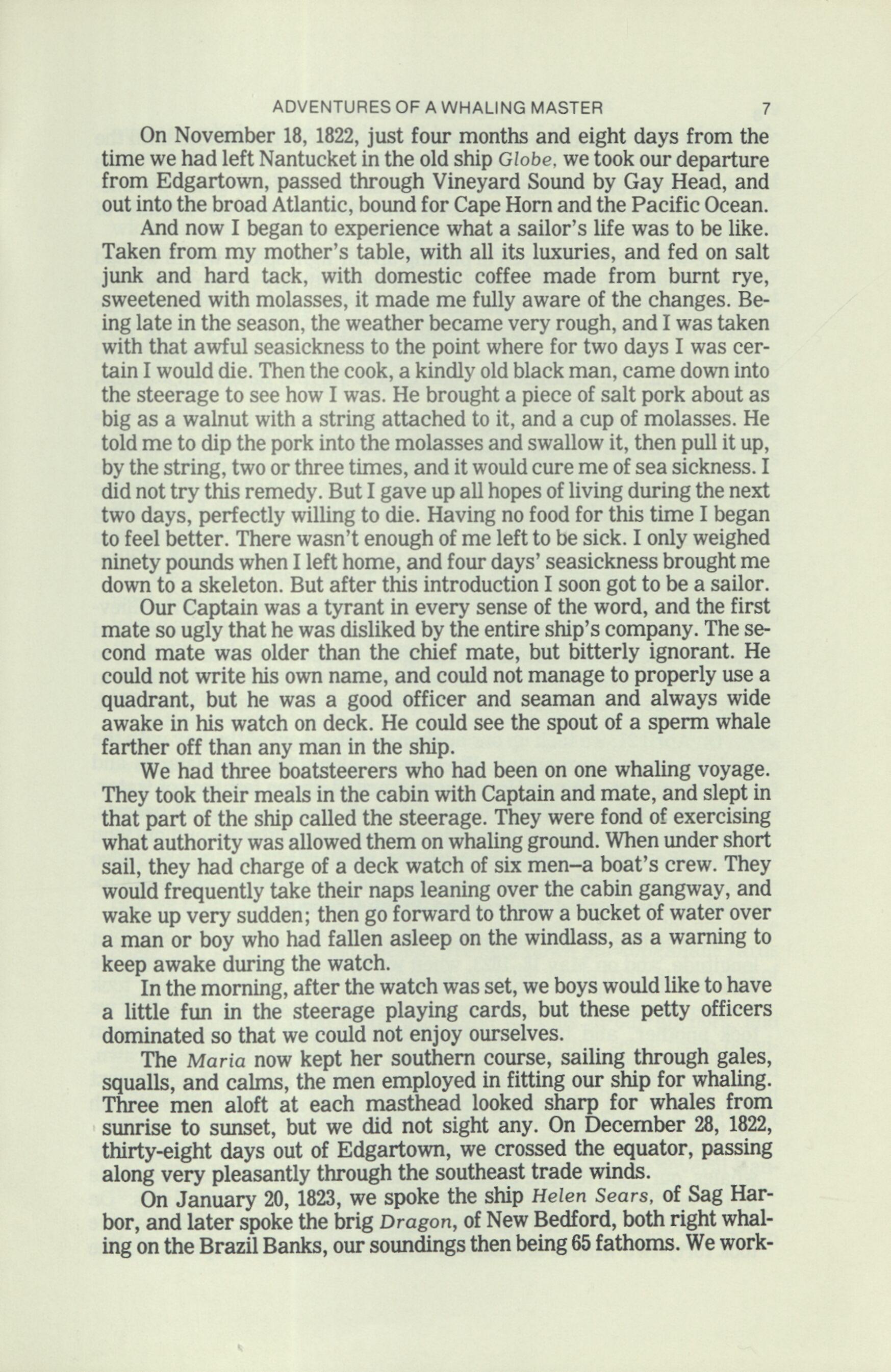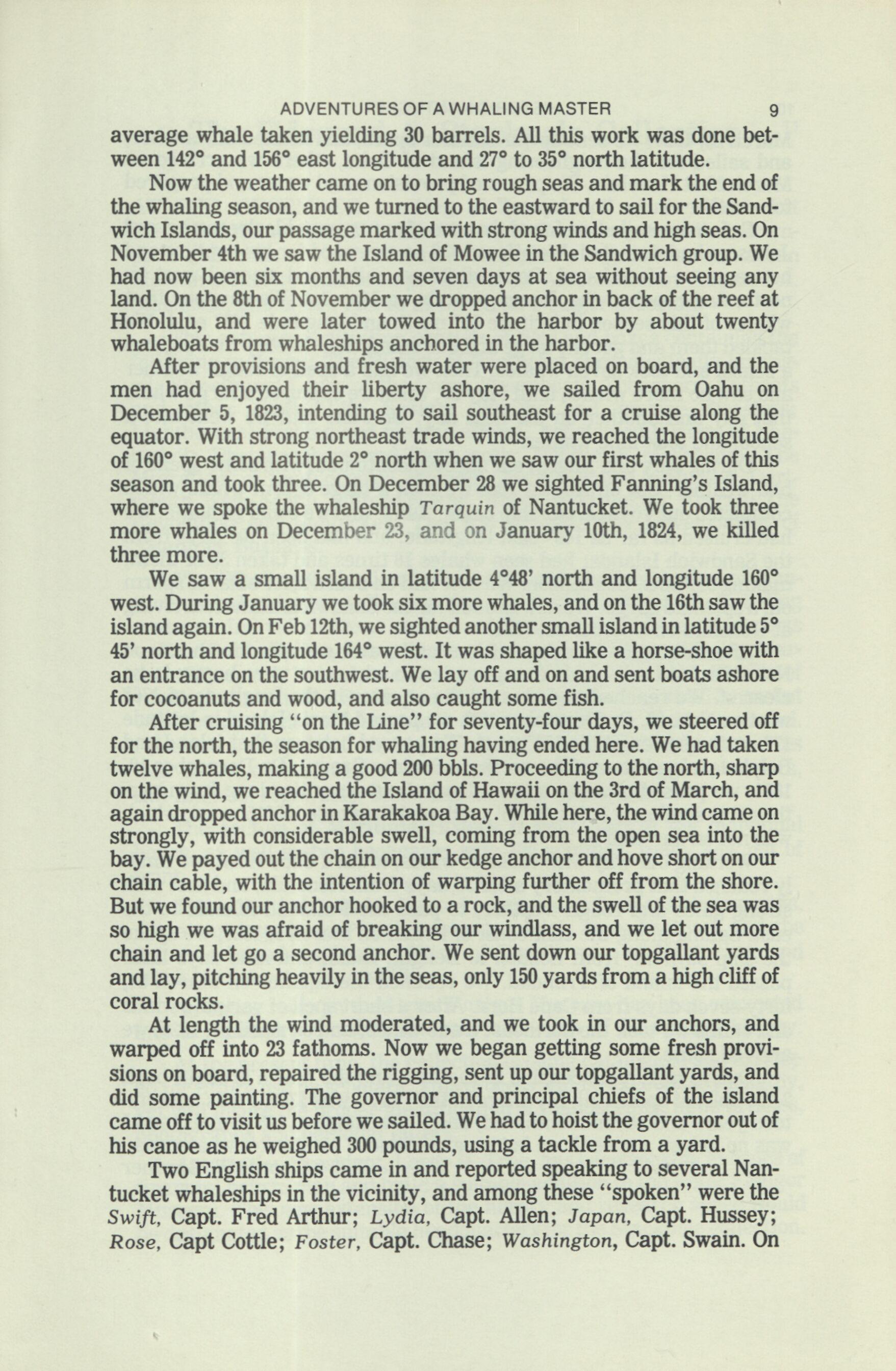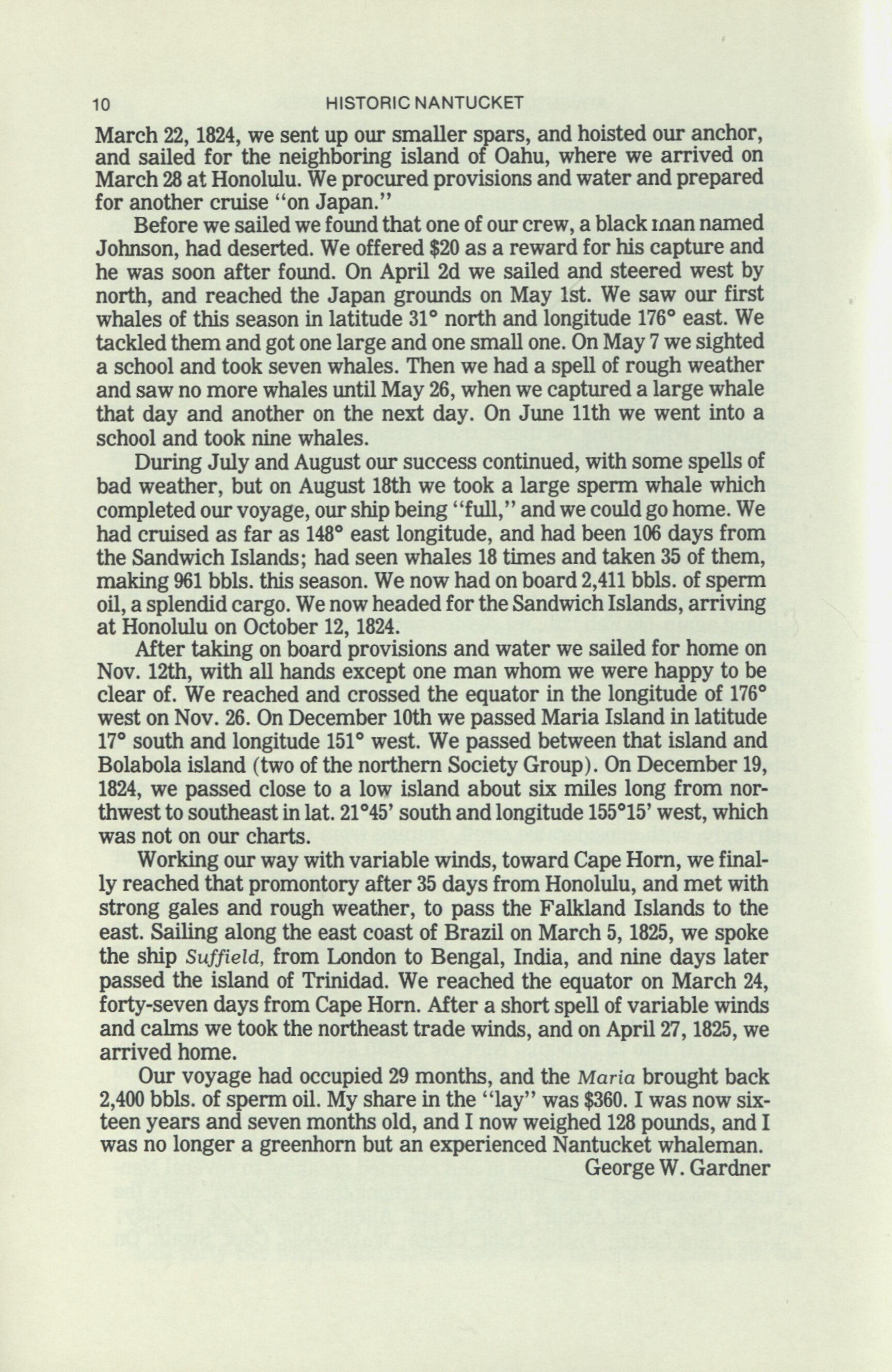
14 minute read
by Captain George W. Gardner
The First Adventures of a Veteran Nantucket Whaling Master
Captain George W. Gardner, one of the best known of the Nantucket whaling masters in the early 19th century, was born in Nantucket on September 13, 1809, and died on October 14, 1896, at the home of his daughter, Mrs. Benjamin Russell, in Concord, Mass. The late Judge Gardner W. Russell was a direct descendant of this redoubtable Island shipmaster, and it is through the courtesy of Mrs. Gardner Russell that we are presenting the story of Captain Gardner, as told by the old whaleman in the closing years of his life.
ON THE 10th DAY of July, 1822, I then being 12 years and 10 months old, I commenced my whaling career by shipping aboard the new
ship Maria of Nantucket, then building at Haddam, on the Connecticut
River. This new whaleship was owned by Christopher Mitchell & Co.,
whose ship Globe had returned from a Pacific voyage (her third in suc
cession) and was in need of repairs, and sailed for Haddam with the provisions needed for the new ship and her crew. And so, I joined the
crew and sailed on the Globe for my new berth on the Maria. As the old Globe was light, and with no topmasts up, she looked like a ship in
distress; in fact, we were hailed during the passage by one vessel which wanted to know if we needed assistance.
When we arrived at Haddam the Maria was still in the stocks at the
shipyard. The contractor and builder were ill, and the carpenters had stopped work for fear they would not be paid. But one of the owners being on the scene now assured their pay, and work resumed. The officers and crew of the ship assisted in carrying on board the new deck beams.
We were then living on board the Globe, moored alongside the river
bank, and, according to the custom of the time, received no pay. Finally, after considerable delay, the new ship was launched and delivered to the owners. I believe the contract price was $9,600, and she was 362 tons burthen.
The master, Captain George W. Gardner Sr., (my father) and the
officers and part of the crew now took charge of the Maria. Her lower
masts were stepped, and she was "hove down" and sheathed and her bottom coppered. Then her topmasts were sent up and she was completely rigged. Her ground tier (lower hold) was filled with casks of water from the river for ballast.
We took our departure for Edgartown on Martha's Vineyard, as it was too late in the season to go over Nantucket Bar. At Edgartown, we found everything necessary for our whaling voyage had been sent over in sloops or lighters from Nantucket, and we took everything on board.
Our outfitting complete, the ship's company was now assembled, with Captain Gardner, the mate, second mate, three boatsteerers (harpooners), and the remainder of the crew sixteen men and a boy, including six black men, making all told twenty-two men.
ADVENTURES OF A WHALING MASTER
7
On November 18, 1822, just four months and eight days from the time we had left Nantucket in the old ship Globe, we took our departure from Edgartown, passed through Vineyard Sound by Gay Head, and out into the broad Atlantic, bound for Cape Horn and the Pacific Ocean.
And now I began to experience what a sailor's life was to be like. Taken from my mother's table, with all its luxuries, and fed on salt junk and hard tack, with domestic coffee made from burnt rye, sweetened with molasses, it made me fully aware of the changes. Being late in the season, the weather became very rough, and I was taken with that awful seasickness to the point where for two days I was certain I would die. Then the cook, a kindly old black man, came down into the steerage to see how I was. He brought a piece of salt pork about as big as a walnut with a string attached to it, and a cup of molasses. He told me to dip the pork into the molasses and swallow it, then pull it up, by the string, two or three times, and it would cure me of sea sickness. I did not try this remedy. But I gave up all hopes of living during the next two days, perfectly willing to die. Having no food for this time I began to feel better. There wasn't enough of me left to be sick. I only weighed ninety pounds when I left home, and four days' seasickness brought me down to a skeleton. But after this introduction I soon got to be a sailor.
Our Captain was a tyrant in every sense of the word, and the first mate so ugly that he was disliked by the entire ship's company. The second mate was older than the chief mate, but bitterly ignorant. He could not write his own name, and could not manage to properly use a quadrant, but he was a good officer and seaman and always wide awake in his watch on deck. He could see the spout of a sperm whale farther off than any man in the ship.
We had three boatsteerers who had been on one whaling voyage. They took their meals in the cabin with Captain and mate, and slept in that part of the ship called the steerage. They were fond of exercising what authority was allowed them on whaling ground. When under short sail, they had charge of a deck watch of six men-a boat's crew. They would frequently take their naps leaning over the cabin gangway, and wake up very sudden; then go forward to throw a bucket of water over a man or boy who had fallen asleep on the windlass, as a warning to keep awake during the watch.
In the morning, after the watch was set, we boys would like to have a little fun in the steerage playing cards, but these petty officers dominated so that we could not enjoy ourselves.
The M a r i a now kept her southern course, sailing through gales, squalls, and calms, the men employed in fitting our ship for whaling. Three men aloft at each masthead looked sharp for whales from sunrise to sunset, but we did not sight any. On December 28, 1822, thirty-eight days out of Edgartown, we crossed the equator, passing along very pleasantly through the southeast trade winds.
On January 20, 1823, we spoke the ship H e l e n S e a r s , of Sag Harbor, and later spoke the brig Dragon, of New Bedford, both right whaling on the Brazil Banks, our soundings then being 65 fathoms. We work-

8
HISTORIC NANTUCKET ed along with variable weather and no unusual circumstances until the 4th day of February. We passed Cape Horn when 78 days from home and 40 days from the Equator. We had strong westerly gales but succeeded in getting far enough to the westward to pass the latitude of Cape Horn, and now sailed along the coast of Chili.
We were then employed in putting up our light spars, which we had to take down in passing Cape Horn. On the tenth day of March we saw our first sperm whales in the latitude of 9°45' south. We lowered our boats but could not get near enough to harpoon any, they being very shy, and after chasing them six hours they went off to windward and out of sight. We continued on our course for the Sandwich Islands, thence to the Japan grounds.
On March 19, 1823, we passed the equator in the longitude of 100° west, and on April 13 we sighted the Island of Hawaii, one of the Sandwich Islands, being then 146 days from home. We passed around the south of the island and ran out of the trade winds but got into the regular land winds and sea breezes and calms, to work our way along the southern shores. On April 16 we came to anchor in Karakakoa Bay, near the spot where the famous Captain Cook was killed. We anchored in 14 fathoms of water.
We found the natives very friendly but with a propensity for thieving. One of them took the cook's axe while he was splitting wood and had laid it aside for a moment. The native jumped overboard with it, to come up alongside his canoe and paddled away. The natives brought in their canoes all the sweet potatoes, cabbages and bananas we needed.
On April 21, we took up our anchor and stood out of the bay with the land breeze in the morning. We coasted along the other islands and came to anchor again at Honolulu on April 24, in ten fathoms of water, just outside the reef. We lay here rafting off water, getting 100 barrels, then took up our anchors and sailed around the southwest end of Oahu Island. We were in company with the whaleship Lady Adams, also from Nantucket. This was the last anyone saw of her, as she was supposed to have burned while on the Japan Grounds.
Proceeding to the northwest we got as far as 147 degrees east longitude, and on May 18,1823, when we were 191 days from home, we took our first sperm whale-a large one. Five days later we took another large sperm and had one boat slightly stove. On June 21st we took another, and two days afterwards we saw a school of sperm whales, got fast to several, but had our lines parted, harpoons drawn, and got only one small whale. However, we found a dead whale the next day. On July 3rd, we took six small whales from a school, and on the 4th we took a large whale.
During the rest of the month and through August we took many whales, our good fortune continuing into September. We lost one whale while he lay alongside when a storm parted the fluke lines. On September 18, we killed our last whale for that season. In 123 days we took forty-two whales and stowed down 1,250 barrels of sperm oil, the

ADVENTURES OF A WHALING MASTER
9 average whale taken yielding 30 barrels. All this work was done between 142° and 156° east longitude and 27° to 35° north latitude.
Now the weather came on to bring rough seas and mark the end of the whaling season, and we turned to the eastward to sail for the Sandwich Islands, our passage marked with strong winds and high seas. On November 4th we saw the Island of Mowee in the Sandwich group. We had now been six months and seven days at sea without seeing any land. On the 8th of November we dropped anchor in back of the reef at Honolulu, and were later towed into the harbor by about twenty whaleboats from whaleships anchored in the harbor.
After provisions and fresh water were placed on board, and the men had enjoyed their liberty ashore, we sailed from Oahu on December 5, 1823, intending to sail southeast for a cruise along the equator. With strong northeast trade winds, we reached the longitude of 160° west and latitude 2° north when we saw our first whales of this season and took three. On December 28 we sighted Farming's Island, where we spoke the whaleship Tarquin of Nantucket. We took three more whales on December 23, and on January 10th, 1824, we killed three more.
We saw a small island in latitude 4°48' north and longitude 160° west. During January we took six more whales, and on the 16th saw the island again. On Feb 12th, we sighted another small island in latitude 5° 45' north and longitude 164° west. It was shaped like a horse-shoe with an entrance on the southwest. We lay off and on and sent boats ashore for cocoanuts and wood, and also caught some fish.
After cruising "on the Line" for seventy-four days, we steered off for the north, the season for whaling having ended here. We had taken twelve whales, making a good 200 bbls. Proceeding to the north, sharp on the wind, we reached the Island of Hawaii on the 3rd of March, and again dropped anchor in Karakakoa Bay. While here, the wind came on strongly, with considerable swell, coming from the open sea into the bay. We payed out the chain on our kedge anchor and hove short on our chain cable, with the intention of warping further off from the shore. But we found our anchor hooked to a rock, and the swell of the sea was so high we was afraid of breaking our windlass, and we let out more chain and let go a second anchor. We sent down our topgallant yards and lay, pitching heavily in the seas, only 150 yards from a high cliff of coral rocks.
At length the wind moderated, and we took in our anchors, and warped off into 23 fathoms. Now we began getting some fresh provisions on board, repaired the rigging, sent up our topgallant yards, and did some painting. The governor and principal chiefs of the island came off to visit us before we sailed. We had to hoist the governor out of his canoe as he weighed 300 pounds, using a tackle from a yard.
Two English ships came in and reported speaking to several Nantucket whaleships in the vicinity, and among these "spoken" were the Swift, Capt. Fred Arthur; Lydia, Capt. Allen; Japan, Capt. Hussey; Rose, Capt Cottle; Foster, Capt. Chase; Washington, Capt. Swain. On

HISTORIC NANTUCKET March 22,1824, we sent up our smaller spars, and hoisted our anchor, and sailed for the neighboring island of Oahu, where we arrived on March 28 at Honolulu. We procured provisions and water and prepared for another cruise "on Japan."
Before we sailed we found that one of our crew, a black man named Johnson, had deserted. We offered $20 as a reward for his capture and he was soon after found. On April 2d we sailed and steered west by north, and reached the Japan grounds on May 1st. We saw our first whales of this season in latitude 31° north and longitude 176° east. We tackled them and got one large and one small one. On May 7 we sighted a school and took seven whales. Then we had a spell of rough weather and saw no more whales until May 26, when we captured a large whale that day and another on the next day. On June 11th we went into a school and took nine whales.
During July and August our success continued, with some spells of bad weather, but on August 18th we took a large sperm whale which completed our voyage, our ship being "full," and we could go home. We had cruised as far as 148° east longitude, and had been 106 days from the Sandwich Islands; had seen whales 18 times and taken 35 of them, making 961 bbls. this season. We now had on board 2,411 bbls. of sperm oil, a splendid cargo. We now headed for the Sandwich Islands, arriving at Honolulu on October 12,1824.
After taking on board provisions and water we sailed for home on Nov. 12th, with all hands except one man whom we were happy to be clear of. We reached and crossed the equator in the longitude of 176° west on Nov. 26. On December 10th we passed Maria Island in latitude 17° south and longitude 151° west. We passed between that island and Bolabola island (two of the northern Society Group). On December 19, 1824, we passed close to a low island about six miles long from northwest to southeast in lat. 21°45' south and longitude 155°15' west, which was not on our charts.
Working our way with variable winds, toward Cape Horn, we finally reached that promontory after 35 days from Honolulu, and met with strong gales and rough weather, to pass the Falkland Islands to the east. Sailing along the east coast of Brazil on March 5,1825, we spoke the ship Suffield, from London to Bengal, India, and nine days later passed the island of Trinidad. We reached the equator on March 24, forty-seven days from Cape Horn. After a short spell of variable winds and calms we took the northeast trade winds, and on April 27,1825, we arrived home.
Our voyage had occupied 29 months, and the M a r i a brought back 2,400 bbls. of sperm oil. My share in the "lay" was $360.1 was now sixteen years and seven months old, and I now weighed 128 pounds, and I was no longer a greenhorn but an experienced Nantucket whaleman. George W. Gardner











